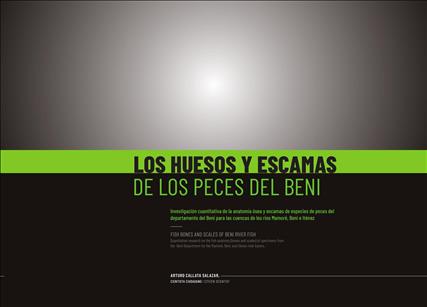Title
Los Huesos y Escamas de los Peces del Beni: Investigación Cuantitativa de la Anatomía ósea y Escamas de Especies de Peces del Departamento del Beni para las Cuencas de los Ríos Mamoré, Beni e Iténez / Fish Bones and Scales of Beni River Fish: Quantitative research on the Fish anatomy (Bones and scales) of Specimens from the Beni Department for the Mamoré, Beni, and Iténez River Basins [medium resolution version]
Author(s)
Arturo Callata Salazar
Published
2022
Abstract
[medium resolution download] El Beni es la cuna de los principales peces amazónicos, donde hasta la fecha, fueron
reportadas 730 especies de peces que habitan nuestros ríos (según datos del proyecto
Amazon Fish). Sin embargo, dada su importante riqueza y diversidad ictiológica, es carente en cuanto informaciones científicas y biológicas sobre estas especies en Bolivia, más precisamente en el departamento del Beni en la ciudad de Trinidad, contamos con un acervo hidrobiológico de especies de interés comercial, el Centro de Investigación de Recursos Acuáticos (CIRA), dependientes de la Universidad Autónoma del Beni - José Ballivian (UAB-JB), pese a su esfuerzo, no alcanza a cubrir la necesidad de más investigaciones en esta área y se ven limitaciones informativas en cuanto a datos cuantitativos. Este hecho manifiesta ante el conocimiento de la riqueza ictícola beniana, la necesidad de generar más investigaciones. El presente trabajo ofrece a la sociedad civil beniana y boliviana, la oportunidad de conocer didácticamente todos los componentes óseos de las principales especies de peces comerciales amazónicos de Bolivia, desde un punto de vista cuantitativo. Se exponen en números distintas estructuras anatómicas ictícolas, hasta hoy no catalogadas y/o investigadas en Bolivia. Por no ser una actividad de bajo costo operativo, las investigaciones futuras dependen del apoyo académico y económico de las distintas instituciones del país; acreditando la reserva de derechos por su investigación de forma compartida entre entes financieros, colaboradores en general y privado, por parte de la Asociación de Pescadores Santísima Trinidad y el autor. / Beni is the cradle of the main Amazon fish, where 730 species inhabiting our rivers have been reported (according to data from the Amazon Fish Project) to date. However, given its important richness and ichthyological diversity, it lacks scientific and biological information on these main species in comparison to other regions in Bolivia. More precisely, in the Department of Beni and the city of Trinidad, we have a hydrobiological collection of species of commercial interest the Aquatic Resources Research Center (CIRA for its acronym in Spanish), sponsored by the Autonomous University of Beni - José Ballivian (UAB-JB), which despite its effort, does not meet the need for more research area where information is limited in terms of quantitative data. This fact, in light of Beni’s fish richness knowledge, brings the need for more research. The present work offers, to the civil society of Beni and Bolivia, the opportunity to learn didactically all bone components of the main commercial fish species in the Bolivian Amazon, from a quantitative point of view. Different anatomical fish structures are presented in numbers until today not cataloged and/or researched in Bolivia. Because it is not a low operating cost activity, future research depends on the academic and economic support of different institutions in the country; the Association of Fishermen Santísima Trinidad and the author would keep the rights for their joint research between financial entities, collaborators in general and the private sector. ISBN: 9789917617068
Full Citation
Callata Salazar, Arturo (2022). Los Huesos y Escamas de los Peces del Beni: Investigación Cuantitativa de la Anatomía ósea y Escamas de Especies de Peces del Departamento del Beni para las Cuencas de los Ríos Mamoré, Beni e Iténez / Fish Bones and Scales of Beni River Fish: Quantitative research on the Fish anatomy (Bones and scales) of Specimens from the Beni Department for the Mamoré, Beni, and Iténez River Basins. La Paz, Bolivia: Wildlife Conservation Society, Bolivia, 1-71.
Access Full Text

Back
DMX4507900000